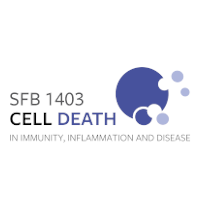Gasdermin D mediates host cell death but not interleukin-1β secretion in Mycobacterium tuberculosis-infected macrophages
Abstract
Necrotic cell death represents a major pathogenic mechanism of Mycobacterium tuberculosis (Mtb) infection. It is increasingly evident that Mtb induces several types of regulated necrosis but how these are interconnected and linked to the release of pro-inflammatory cytokines remains unknown. Exploiting a clinical cohort of tuberculosis patients, we show here that the number and size of necrotic lesions correlates with IL-1βplasma levels as a strong indicator of inflammasome activation. Our mechanistic studies reveal that Mtb triggers mitochondrial permeability transition (mPT) and subsequently extensive macrophage necrosis, which requires activation of the NLRP3 inflammasome. NLRP3-driven mitochondrial damage is dependent on proteolytic activation of the pore-forming effector protein gasdermin D (GSDMD), which links two distinct cell death machineries. Intriguingly, GSDMD, but not the membranolytic mycobacterial ESX-1 secretion system, is dispensable for IL-1βsecretion from Mtb-infected macrophages. Thus, our study dissects a novel mechanism of pathogen-induced regulated necrosis by identifying mitochondria as central regulatory hubs capable of delineating cytokine secretion and lytic cell death.
Read more at Cell Death Discovery (2021)7:327
